Understanding Hamster Pregnancy & Care Tips
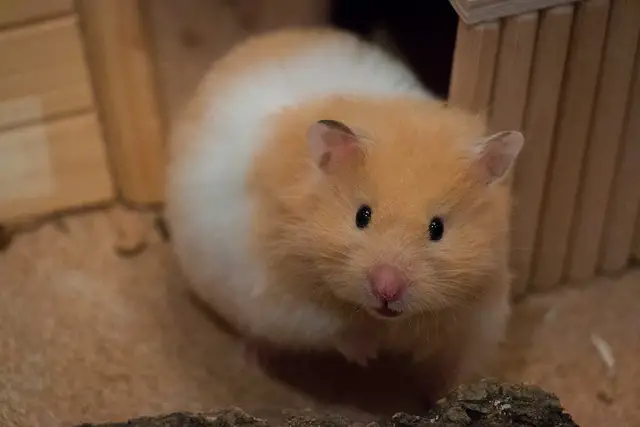
Are you ready to dive into the world of hamster pregnancy? Whether you’re a proud hamster parent or just curious about these adorable little creatures, this blog post is for you.
We’ll be exploring the ins and outs of hamster pregnancy, from the signs of a pregnant hamster to what to expect during the birth process.
How long is the gestation period for hamsters
The gestation period for hamsters can vary depending on the species.
Syrian hamsters typically have a gestation period of 16–17 days, while dwarf hamsters, Chinese hamsters, and Roborovski hamsters have gestation periods of 18–21 days.
It’s important to note that these are average durations, and there can be slight variations.
Signs of Hamster Pregnancy
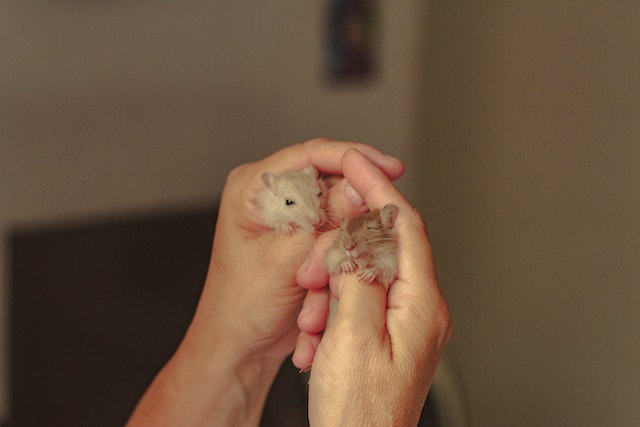
The following are some common ways of identifying hamster pregnancy:
1. Changes in Behavior
Hamsters, like any other animal, can undergo mood changes during pregnancy. Just like some pregnant humans experience mood swings due to hormonal fluctuations, pregnant hamsters might become a bit more irritable or restless.
This can be attributed to the changes happening within their bodies as they prepare to nurture a new generation. Keep an eye out for any unusual behavior that might indicate this subtle shift in temperament.
2. Visible Belly Changes
As pregnancy progresses, you might notice a subtle change in the shape of your hamster’s belly. It becomes more rounded and slightly distended due to the growing fetuses.
Be gentle when observing this physical change, as hamsters can be sensitive to handling, especially during pregnancy.
3. Weight Gain
A key indicator of pregnancy in hamsters is a noticeable gain in weight. Similar to pregnant humans, hamsters accumulate extra weight due to developing fetuses and the associated changes in their bodies.
To monitor this change accurately, regularly weigh your hamster and record the measurements. Any significant increase in weight might be a sign that she’s expecting.
4. Nesting Behavior
Pregnant hamsters exhibit a fascinating instinct to prepare for the impending arrival of their babies by creating a cozy nest.
They’ll gather bedding materials, such as shredded paper or tissue, and arrange them in a comfortable corner of their enclosure.
This behavior is an unmistakable sign that her maternal instincts are kicking in as she readies herself for motherhood.
5. Increased Appetite
As pregnancy progresses, hamsters experience heightened energy needs to support the growing babies. This often leads to an increase in appetite.
You may notice your hamster consuming more food than usual. It’s vital to ensure she has access to a well-balanced diet rich in nutrients and protein to fuel her body’s demands during this important time.
6. Visible Kicking or Movement
During the later stages of pregnancy, if you gently place your hand on your hamster’s belly, you might be able to feel or even see slight kicks or movements.
This heartwarming experience allows you to connect with the life growing inside her. Always be respectful of her comfort and space when attempting to feel these movements.
7. Visible Nipple Development
One of the telltale signs of impending hamster motherhood is the noticeable development of nipples.
As the body prepares for lactation, the nipples become more prominent and might change in color. Gently inspect your hamster’s belly to spot these changes, but avoid excessive handling to prevent stress.
8. Fur Changes
Hormonal fluctuations during pregnancy can lead to alterations in a hamster’s fur. Some might experience fur loss, particularly around the belly area, which is normal due to the stretching of the skin.
Others might have changes in fur texture or appearance. These fur-related changes are temporary and should normalize after pregnancy.
9. Reduced Activity
It’s not uncommon for pregnant hamsters to become less active than usual. The added weight from the growing embryos can make movement less comfortable, prompting them to spend more time resting.
This reduced activity is a natural response to the physiological changes their bodies are undergoing.
10. Change in Sleeping Patterns
Pregnant hamsters might experience shifts in their sleeping habits. Some might sleep more than usual, while others might find it challenging to sleep due to discomfort.
Providing a quiet, stress-free environment can help her get the rest she needs to support her growing body and the upcoming birth.
Caring for a Pregnant Hamster
Here are some common ways to care for a pregnant hamster:
1. Proper Nutrition: Provide a balanced diet that includes a variety of fresh fruits, vegetables, and commercial hamster pellets. Pregnant hamsters require additional protein and calcium, so consider supplementing their diet with small amounts of cooked chicken or eggs and calcium-rich foods like yogurt or cheese.
2. Adequate Hydration: Ensure that the pregnant hamster has access to fresh, clean water at all times. You can use a water bottle designed for small animals to provide a constant supply of water.
3. Comfortable Nesting Area: Provide a suitable nesting area for the pregnant hamster. This can be a small box or a nesting house filled with soft bedding material such as shredded paper or unscented tissue. Make sure the nesting area is located in a quiet and undisturbed part of the cage.
4. Regular Cage Cleaning: Clean the cage regularly to maintain a clean and hygienic environment for the pregnant hamster. Remove any soiled bedding and waste, and replace it with fresh bedding material.
5. Minimize Stress: Pregnant hamsters can be sensitive to stress, so try to minimize loud noises, sudden movements, and excessive handling. Provide a calm and quiet environment to help reduce stress levels.
6. Regular Veterinary Check-ups: Schedule regular check-ups with a veterinarian who is experienced in small animal care. Regular veterinary care can help monitor the health of the pregnant hamster and address any potential issues.
7. Monitoring Weight Gain: Monitor the pregnant hamster’s weight gain throughout the gestation period. A pregnant hamster should gradually gain weight, but sudden or excessive weight gain can indicate potential problems and should be checked by a veterinarian.
8. Separation from Other Hamsters: Pregnant hamsters should be separated from other hamsters, including the father, to prevent any potential aggression or stress. This separation is important to ensure the safety and well-being of the mother and her babies.
9. Postnatal Care: After the hamster gives birth, continue to provide a clean and comfortable environment for the mother and her offspring. Handle the babies with extreme care and avoid disturbing the nest unnecessarily.
Creating a hamster birthing area within the nesting space
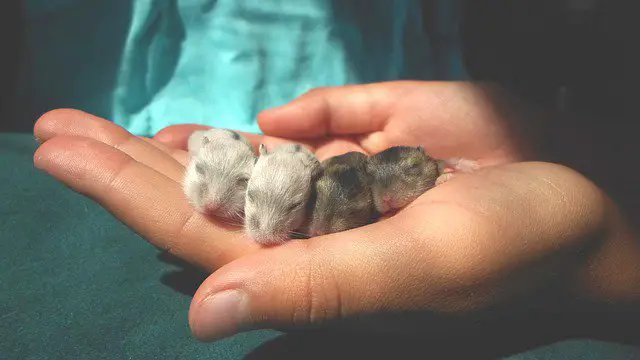
Creating a suitable birthing area within the nesting space for a hamster is important to ensure a safe and comfortable environment for the mother and her babies. Here are some steps to consider:
1. Provide a nesting box: Hamsters have a natural instinct to create nests and will appreciate a designated area for giving birth. Place a small nesting box in the enclosure, preferably made of non-toxic materials like wood or plastic. Make sure it has low sides to allow easy access for the mother.
2. Add nesting material: Fill the nesting box with suitable nesting material, such as shredded paper, clean and unscented tissues, or soft bedding specifically designed for small animals. Avoid using materials that could be harmful or too dusty.
3. Ensure privacy: Hamsters prefer privacy during the birthing process. Place the nesting box in a quiet and secluded area of the enclosure, away from any disturbances or loud noises. This will help the mother feel secure and reduce stress.
4. Maintain appropriate temperature: Hamster babies are sensitive to temperature fluctuations. Ensure that the nesting area remains at a constant temperature between 65-75°F (18-24°C). Avoid placing the enclosure in direct sunlight or near drafts.
5. Provide easy access to food and water: Place a small dish of fresh water and a separate dish of hamster-friendly food near the nesting area. This will allow the mother to easily access nourishment without having to leave her babies for extended periods.
6. Monitor the birthing process: Keep a close eye on the mother hamster during the birthing process. Avoid unnecessary handling or disturbances, as this can cause stress and potentially harm the babies. If you notice any complications or concerns, consult a veterinarian experienced in small animal care.
What to expect during a hamster labor process
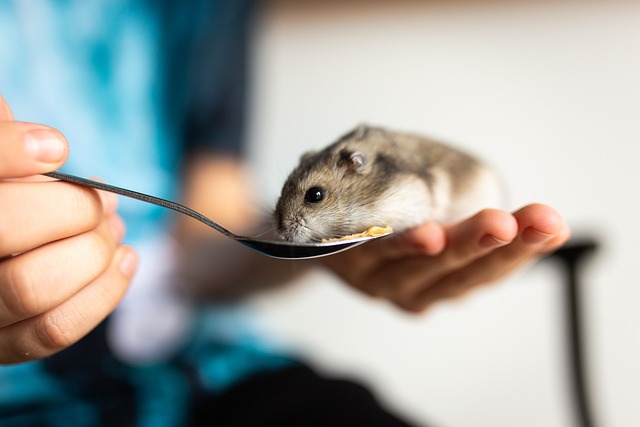
During a hamster labor process, there are several things that you can expect to occur. Here is what to expect during a hamster labor process:
Nesting Behavior: Prior to giving birth, a pregnant hamster will usually exhibit nesting behavior. This includes gathering bedding materials, such as shredded paper or hay, to create a comfortable nest for the upcoming birth.
Increased Abdominal Size: As the pregnancy progresses, you may notice a slight increase in the hamster’s girth or a larger abdomen. This is a normal sign of pregnancy and indicates that the hamster is preparing for birth.
Decreased Activity: As the hamster approaches labor, you may notice a decrease in her activity level. She may spend more time in her nest and become less interested in exploring or interacting with her surroundings.
Contractions: During labor, the hamster will experience contractions. These contractions help to expel the pups from the birth canal. You may notice the hamster straining or pushing during this time.
Delivery of Pups: The actual delivery of the pups can vary in duration. It is not uncommon for hamsters to give birth to multiple pups within a short period of time. The pups are typically born in a thin, transparent sac, which the mother will usually remove and eat. She will then clean the pups and nurse them.
Postpartum Care: After giving birth, the mother hamster will continue to care for her pups. She will nurse them, keep them warm, and clean them regularly. It is important to provide a quiet and stress-free environment for the mother and her pups during this time.
It’s worth noting that while hamster labor is generally a natural process, complications can occur.
If you have any concerns about your hamster’s labor or if you notice any signs of distress or difficulty during the process, it is recommended to consult with a veterinarian who specializes in small animals for further guidance and assistance.
Birth process and the appearance of newborn hamsters
The birth process of hamsters, also known as parturition, involves the delivery of newborn hamsters, or pups.
During the birth process, there are several changes that occur in the appearance of the newborn hamsters. These changes are important for their survival and development.
Appearance at Birth:
- Naked and Blind: Hamster pups are born naked and blind. They do not have fur, and their eyes are closed. This is true for all hamster species.
Development after Birth:
- Rapid Growth: Hamster pups grow very rapidly. Within a week, they start developing fur and their eyes begin to open.
- Teeth Emergence: When hamsters are about a week old, their teeth start to emerge. This is an important milestone in their development.
- Nestling Behavior: After birth, the mother hamster will clean each baby as it is born and tuck it into the nest. This is to keep them warm and protected.
- Parental Care: In some species of hamsters, such as Djungarian hamsters (Phodopus campbelli), both males and females contribute to pup care and provide parental care during the birth process.
It is worth noting that hamsters give live birth, unlike some other small mammals that lay eggs. The birth process can vary in duration, and it could happen quickly or take several hours.
Learn more about taking care of your hamster.
Caring for a hamster mother and her litter after birth
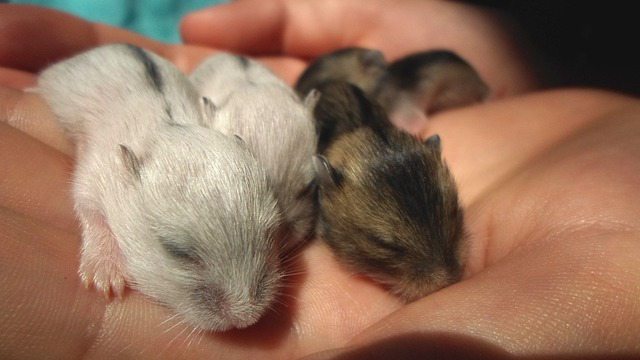
Caring for a hamster mother and her litter after birth is crucial to ensure the health and well-being of both the mother and the babies.
Here are some important steps to take:
Create a Comfortable and Safe Environment
- Provide a clean, spacious cage for the hamster family. Make sure the cage has enough bedding material for the mother to build a nest for her babies.
- Ensure that the cage is secure and has no gaps or openings where the babies could escape.
- Place the cage in a quiet area away from loud noises and disturbances to minimize stress for the mother and her babies.
Allow Privacy and Minimal Handling
- It’s important to give the hamster’s mother and her litter privacy during the first few days after birth. Avoid excessive handling or disturbing the nest unless necessary.
- Limit interactions with the hamsters to feeding and cleaning the cage to minimize stress and potential harm to the babies.
Provide a Proper Diet
- The mother hamster will need a nutritious diet to support her milk production. Provide a high-quality hamster food that contains a balanced mix of seeds, grains, and pellets.
- Fresh, clean water should always be available for the mother and her litter. Ensure that the water bottle or dish is easily accessible and regularly refilled.
Monitor the Mother’s Behavior and Health
- Observe the mother’s hamster closely to ensure she is caring for her babies properly. Most hamster mothers are instinctively attentive and will nurse, groom, and protect their young.
- If you notice any signs of neglect or aggression towards the babies, it may be necessary to separate the mother from the litter and hand-raise the babies with appropriate guidance from a veterinarian or experienced hamster breeder.
Gradually Introduce Solid Food
- Around three weeks of age, the baby hamsters will start to show interest in solid food. Introduce small amounts of hamster food, fresh vegetables, and occasional treats to their diet.
- Gradually wean the babies off their mother’s milk by providing them with a variety of age-appropriate solid foods.
Separate the Babies
- Once the baby hamsters reach around four weeks of age, it is recommended to separate them from the mother to prevent any potential breeding or aggression issues. Provide each baby hamster with its own appropriately sized cage or find suitable homes for them.
Remember, it’s always a good idea to consult with a veterinarian or an experienced hamster breeder for specific guidance and advice on caring for a hamster’s mother and her litter after birth. They can provide valuable insights and ensure the best care for the hamsters.
Learn more about why hamsters eat their babies.
Related Questions
Can I breed my hamsters at home?
Breeding hamsters at home requires careful consideration. It’s essential to provide a suitable environment and ensure the health and well-being of both male and female hamsters. Breeding should be done responsibly, with proper knowledge and preparation.
How can I tell if my hamster is pregnant?
Identifying pregnancy in hamsters can be challenging, as they don’t show obvious physical signs until later stages. However, you may notice weight gain, changes in behavior, and nesting behavior as possible indications. If you suspect your hamster is pregnant, consult a veterinarian for confirmation and guidance.
Should I separate the male and female hamsters during pregnancy?
It’s crucial to separate the male and female hamsters as soon as the female becomes pregnant. Hamsters are solitary animals and may become aggressive toward each other, potentially harming the pregnant female or her offspring.
How many babies can a hamster have in a litter?
The number of babies in a hamster’s litter can vary depending on the species and individual hamster. On average, hamsters can have anywhere from 4 to 12 pups in a single litter. It’s important to provide a suitable nesting area and monitor the health of the mother and babies closely.
When can I handle the baby hamsters?
It’s best to avoid handling the baby hamsters for the first week after they are born. During this time, the mother is highly protective, and any disturbance can cause stress. After the first week, you can gradually introduce gentle handling, always ensuring the safety and well-being of the baby hamsters.
Learn more about keeping two female hamsters together.
Conclusion
In conclusion, the journey of hamster pregnancy is an incredible and awe-inspiring experience. From the moment those tiny paws start to wiggle inside their mama’s belly, to the day they enter this world, it’s a rollercoaster of emotions for both the hamster and their human caretaker.
As we’ve explored in this blog post, it’s crucial to provide the necessary care, nutrition, and a stress-free environment for our pregnant hamster friends.
So, whether you’re a seasoned hamster parent or considering adding a furry bundle of joy to your life, remember to embrace the miracle of hamster pregnancy with love, patience, and a whole lot of excitement!
